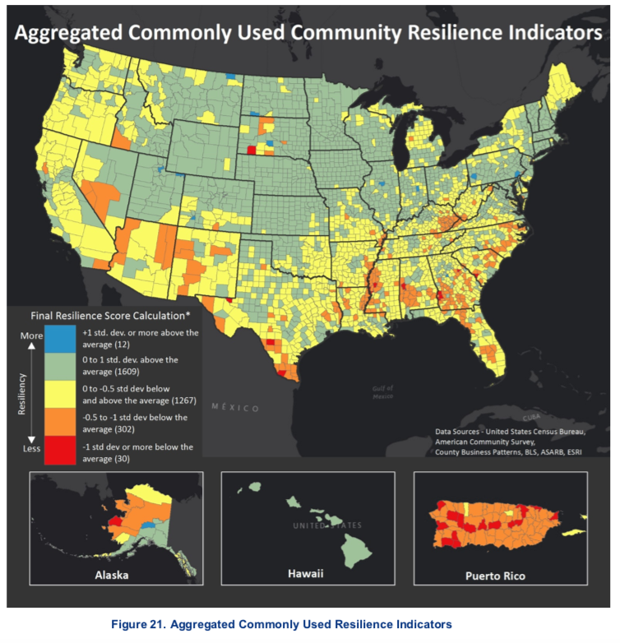Community resilience indicators
How would society survive a great disaster? Nassim Taleb argues that the profoundly destructive Black Swan events that define human history are fundamentally unpredictable. Nevertheless, he argues, such events can be planned for by making society more "antifragile". Up to a point, antifragile systems not only manage to survive uncertainty and hardship, but end up benefiting from such shocks.How does one make society antifragile in terms of natural disasters?
It's FEMA to the rescue.
The Federal Emergency Management Agency has compiled commonly used resilience indicators.
They are listed on Table 1 on page seven (7) in the following PDF.
https://www.fema.gov/media-library-data/1549906639681-ac6f6d5fb54af1649f0077feed876b9e/Community_Resilience_Indicator_Analysis_December_2018_508.pdf
Population-Focused Indicators:
- Educational Attainment
- Unemployment Rate
- Disability
- English Language Proficiency
- Home Ownership
- Mobility (geographic)
- Age
- Household Income
- Income Inequality
- Health Insurance
- Single-Parent Household
- Connection to Civic and Social Organizations
- Hospital Capacity
- Medical Professional Capacity
- Affiliation With a Religion
- Presence of Mobile Homes
- Public School Capacity
- Population Change
- Hotel/Motel Capacity
- Rental Property Capacity

A new study finds that those cities which are most vulnerable to natural disasters -- heat waves, flooding, rising seas, drought -- are the least prepared.
https://www.citylab.com/environment/2019/08/climate-impacts-resilient-cities-environmental-justice/596251/
"Gross National Antifragility"
To some extent, the list of resilience indicators corresponds with factors linked with social mobility.https://www.smartcitiesdive.com/ex/sustainablecitiescollective/income-mobility-rankings-harvard/1070681/
- less segregation by income and race;
- lower levels of income inequality;
- better schools;
- lower rates of violent crime; and
- a larger share of two-parent households.
Currently, there is a tendency to look at urban growth in terms of population and incomes.
https://www.citylab.com/life/2019/08/job-ranking-top-cities-population-growth-census-data-us/596485/
The concept of national growth always needs to be interrogated.
At the national level, at one time, economic progress was measured in terms of how many railroad cars existed in a country. This was replaced later with measures like the GNP and the GDP. Serious alternatives to this have been proposed.
https://en.wikipedia.org/wiki/Gross_domestic_product#Proposals_to_overcome_GDP_limitations
- The capability approach, measuring citizens' functional capacity rather than wealth.
- The Human Development Index, which includes literacy rates and life expectancy.
- The Index of Sustainable Economic Welfare, which includes environmental costs.
- Gross National Well-being includes economic, educational, health, environmental, governmental, work and societal indicators.
Again, resilient community indicators seem to resonate with both social mobility factors and with Taleb's notion of "antifragility".
This resonance might also hold true for some of the indicators for alternative measures of national well-being. These too could be incorporated as indicators of Gross National Antifragility.
"Well-being": American happiness versus realistic joy
The real distinction to be made here is not between various indexes of well-being.The real variation is in temperament and attitude and how well-being or "happiness" is defined separately from these indexes, and the way the indexes are subsequently interpreted.
The classic American attitude is that happiness is a permanently emotional endpoint achieved by accruing worldly possessions -- a materialistic version of the Christian concept of Heaven. In the past, this implied hard work, but this might no longer be the case. Hundreds of years ago, the "American dream" was religious freedom; later, this dream evolved into the goal of establishing a republic; by the 2000s, the American dream was to own a gigantic fiberboard house in the suburbs; by the 2010s, the American dream morphed into the "California dream" of attaining wealth and fame without effort or talent (Kardashians). By most indexes of well being, the Kardashians are healthy and wealthy and empowered. So the indexes of well-being in themselves can be misleading when they used to support the wrong value system. The things that are associated with happiness typically represent permanence, security, rootedness and finality: marriage, family, professional success, fame, houses, domesticity. This is a false sense of security, and signifies the preference of the merely robust over the antifragile.
Antifragility likewise involves a notion of well-being -- specifically, the brief joy of managing to survive a trauma that makes one stronger. Health, education and wealth and other indexes of well-being are essential in order to survive hardship, and when hardship is overcome, health and wealth and education often increase. But this joy is based on temporarily overcoming serious obstacles, as opposed to the common fantasy of permanently escaping from obstacles by amassing a fortress of wealth. Although the various indexes are valid insofar as they promote antifragility, they are usually interpreted in a quasi-Christian, materialistic way as promoting security and consumerism.
Happiness is not the same thing as joy. Ordinary Americans choose the illusion of happiness, whereas the artist chooses a brief spasm joy with each hard-won accomplishment.
["Le Plaisir", 1952, ending of final part, "La Modele"]
The indicators of well-being are misinterpreted by decision makers to emphasize quantity over quality (success means more money and more people and big houses, etc.), happiness over joy, the illusion of attaining permanent security over the reality of the temporary, the robust over the antifragile.